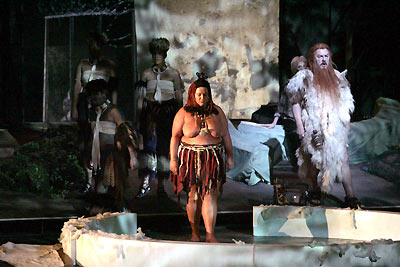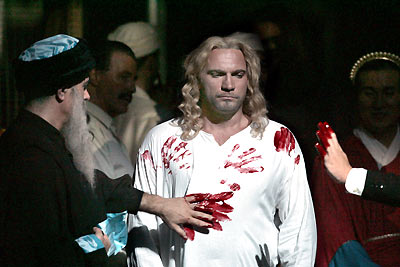 |
 |
|
 |
 |
Parsifal - Schlingensief´s new staging at the
Richard Wagner Festival Bayreuth (2004 − 2007)
Wagner Festival Bayreuth, Germany by Anna-Catharina Gebbers
In 1965 Joseph Beuys performed How to Explain Pictures to a Dead Hare. In Christoph Schlingensief's production of Parsifal,
which opened this year's Wagner Festival in Bayreuth, Beuys' famous version of the Pietà is acted out by Klingsor, the eerie
knight in black armour, in the opera's central act: he holds a man-size toy hare (which recalls a sculpture by Louise Bourgeois)
and laments.
It's not, however, the only dead hare; one could say that Schlingensief explains pictures to a whole school of them. His
Parsifal is baroque, an overflowing ocean of signs and symbols; as Gurnemanz tells his son, ’Time here become space'. The
rotating stage is a cyclical metaphor, like Beuys' Honey Pump in the Work Place (1974-7), offering an abundance of
meanings in which the spectator can revel without ever gaining the impression of having seen, let alone of having understood,
everything. Film material and costumes integrate the prehistory from Wolfram von Eschenbach's medieval epic poem Parzival
into Wagner's reworking. Large-formate projections, close-ups of a slowly rotting hare and pulsating maggots bring a
contemporary visual idiom into the historic confines of the Festspielhaus. Slogans in the style of Jonathan Meese, such
as Zeichen Worte Malen (Signs Words Painting), Kraal (Grail) or Betpunk (Prayer Punk), adorn elements
of the stage set, suggesting modes of interpretation.
 |
| Picture from Schlingensief´s production of Parsifal (Image: Bayreuth) |
With interrupted rehearsals and rumours of legal wrangles over the months before the opera opened, Schlingensief became the
focus of an unparalleled media spectacle, a fact reflected in his production. In every scene he plays with the institutional
framework that is Bayreuth, celebrating chaos, tormenting the audience with incomprehensibility and then winning it back with
skilfully placed key set pieces. The director challenges the audience to a play a game in which the artist refuses to be the
one who gives up first, and in so doing has created a kind of Gesamtkunstwerk a popular Parsifal in the best possible sense,
capable of bringing together art-lovers, intellectuals, sensation-seekers and loyal Wagnerians. The enigmatic aspect of the
Mistery Play is preserved, but each spectator comes away with his or her own particular revelation. In one film scene a black
Matthew Barney-like persona is received as a saviour. Like Barney, Schlingensief has found a distinctive vocabulary that puts
his stamp on all the elements of Wagner's ’sacred drama'. Not only does this Bayreuth production mark a redeeming, brilliant
high point in Schlingensief's directing career; his numerous films, theatre projects and art happenings now fall into place
as part of an oeuvre with consistent leitmotiv. As a result, the weary stronghold of the Wagnerian grail has opened up to the
future.
 |
| Picture from Schlingensief´s production of Parsifal (Image: Bayreuth) |
But where was Marcel Duchamp's urinal (Fountain, 1917)? At the première it was missing from the on-stage ’Graveyard of Art',
where it was meant to rest in place alongside Leonardo da Vinci's Mona Lisa (1503-6), Van Gogh's ’Sunflowers' (1888-9)
and Andy Warhol's Campbell's Soup Cans (1961-2). Rumour has it that the festival's director, Wolfgang Wagner, himself
whisked it away to a safe hiding place before the performance.
Translated by Nicholas Grindell
Additional information on Schlingensief`s and his Parsifal
|
 |
 |
 |
|
 |